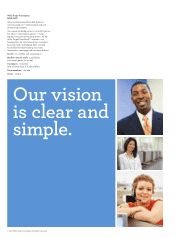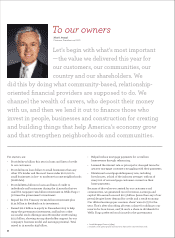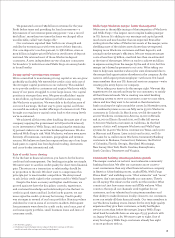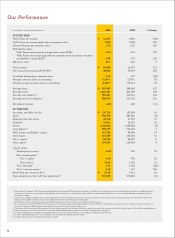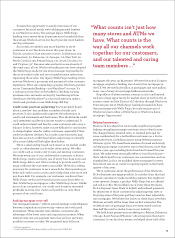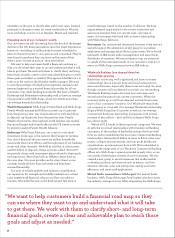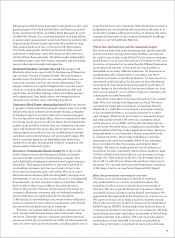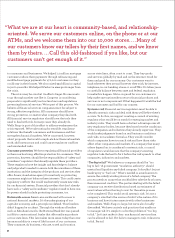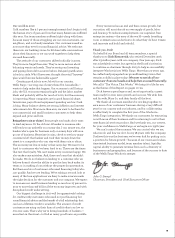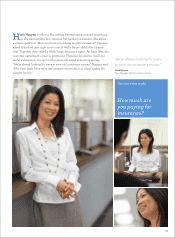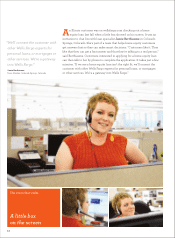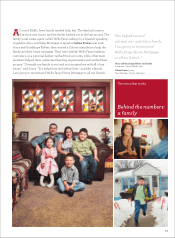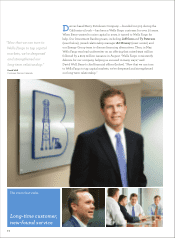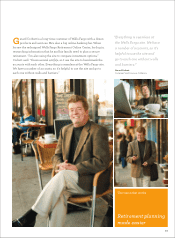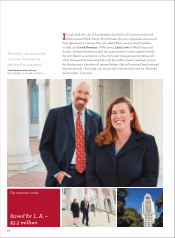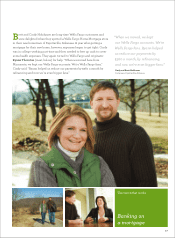Wells Fargo 2009 Annual Report Download - page 10
Download and view the complete annual report
Please find page 10 of the 2009 Wells Fargo annual report below. You can navigate through the pages in the report by either clicking on the pages listed below, or by using the keyword search tool below to find specific information within the annual report.
to consumers and businesses. We helped 1.2 million mortgage
customers reduce their payments through refi nancing and
modifi ed mortgage payments for 470,000 customers so they
could stay in their homes. We also raised $33 billion in capital
in just 14 months. We helped Wachovia emerge stronger from
the crisis.
The crisis may be over but its e ects linger. No one wants
to go through another one like it. Congress is considering
proposals to signifi cantly restructure laws and regulations
governing fi nancial services. We’re part of this process. We
believe all fi nancial services companies must be subject to
strong, e ective regulation. All consumers should have
strong protection, no matter what company they deal with.
All fi nancial service regulators should have the tools they
need to deal with risk. In many cases they already do.
Wells Fargo is part of this e ort to address weaknesses the
crisis exposed. We’re advocating for sensible, regulatory
solutions that benefi t consumers and businesses and that
strengthen fi nancial markets. We’re concerned, however,
about proposals that would complicate how fi nancial markets
work, add bureaucracy and could cause regulatory confl icts
and unintended risks.
Consumer protection We favor regulating all fi nancial providers
so there can be strong, e ective protection for consumers. That
protection, however, should be the responsibility of “safety and
soundness” regulators that already regulate these providers.
These regulators have the insight and knowledge to balance
and judge what’s needed to ensure both the soundness of these
institutions and the integrity of the products and services they
o er. A new, stand-alone agency focused only on protecting
consumers might not balance these interests. This could create
regulatory confl icts that would inadvertently create new risks
for our fi nancial system. Financial providers that don’t already
have such a “safety and soundness” regulator need to have one.
Its powers should include protecting consumers, too.
Nationwide access Americans are blessed with access to
national fi nancial markets. It’s the underpinning of our
capitalist economy, and a principle we defend. This freedom
didn’t happen by accident. Through the wisdom of leaders
such as Abraham Lincoln, the National Bank Act was passed
in 1864 to create national banks that o er uniform products
across state lines. This law makes more sense today than ever
because mobility is a way of life for most of our customers.
They commute, do business, relocate, travel and vacation
across state lines, often coast to coast. They buy goods
and services globally by mail and on the internet. Good for
them and good for our economy. Our customers want to
bank wherever they are and however they wish, by internet,
telephone, in our banking stores or our ATMs. It’s taken years
to carefully balance between state and federal regulation
to make this happen. We’re on guard for our customers to
help make sure nationwide access to fi nancial products and
services is not compromised. If that happened it would be bad
for our customers and bad for our country.
Systemic risk Financial service regulators must be able to
identify systemic risks and deal with them well before there’s
a crisis. To do this, we support creating a council of existing
regulators that would be on watch for emerging market and
industry risks. They would have a distinct advantage over all
new regulatory bodies, because they know best the conditions
of the companies and industries they already supervise. They
would make judgments based on real business conditions
and risks, not academic formulas. They would consider
which companies have too much risk and how those risks
a ect other companies and markets. If a company that many
others depend on is considered a systemic risk, a council
of regulators would ensure that the company’s existing
regulator take the lead to fi x it before the risk spreads to other
companies, industries and markets.
“Too big to fail” We believe no company should be “too
big to fail.” A government “resolution authority” should
unwind and liquidate any failed company. It shouldn’t be just
bankruptcy or “bail out.” What’s needed is a mechanism to
assure the orderly winding down of a failed company. The
process needs to assure that stockholders take the fi rst losses,
then unsecured creditors. The parties dealing with the failed
company can receive distributions based on estimates of
asset values without having to wait for the entire process
to be completed. This would avoid systemic risk. It’s not a
company’s size that’s the source of risk it’s the nature of its
business and how it interconnects with other businesses
and markets. Wells Fargo is large, but we’re also broadly
diversifi ed. We have controls and practices that enable us
to manage risk. It’s simple to solve the problem of “too big
to fail.” Let’s just make it clear: any fi nancial services fi rm
can be allowed to fail. If it fails to manage its risk, it deserves
to fail. Period.
“ What we are at our heart is community-based, and relationship-
oriented. We serve our customers online, on the phone or at our
ATMs, and we welcome them into our 10,000 stores. ...Many of
our customers know our tellers by their fi rst names, and we know
them by theirs. ...Call this old-fashioned if you like, but our
customers can’t get enough of it.”


